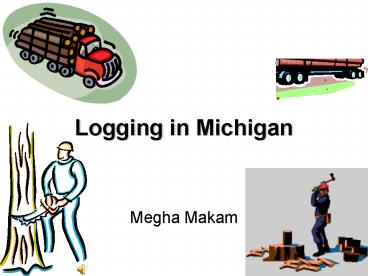Logging in Michigan PowerPoint PPT Presentation
1 / 19
Title: Logging in Michigan
1
Logging in Michigan
- Megha Makam
2
- Most of Michigan's densely-forested land is in
the western UP, where over 90 of the surface is
forested
3
- A composite map showing the relative density of
forest on the landscape. Greener more dense.
4
- The earliest lumbering was done by the French.
- Built forts, fur-trading, posts and missions.
- The British, and later the Americans, used
Michigans hardwoods to build merchant and war
ships.
5
- Michigans pine became important as the supply of
trees in the northeast was used. By 1880,
Michigan was producing as much lumber as the next
three states combined.
6
- Hardwood lumbering in the north part of the Lower
Peninsula occupied the period from 1890 to 1920,
and cutting of the remaining virgin hardwood
stands continued in the western end of the Upper
Peninsula until about 1950.
7
One area that has remained in stumps and has not
regenerated to forest lies near Pictured Rocks,
in the central UP. This area, the Kingston
Plains, is a often referred to as a "stump
prairie". The Kingston Plains, a flat, sandy
landscape, contained a large white pine forest at
the time of logging the 1890's.
http//www.geo.msu.edu/geo333/kingstonplains.html
8
1995 Kingston Plains Stump Prairie
9
- The lumber industry also enabled Michigan to
become a leader in pulp and paper production.
Changes in papermaking technology is the 1870s -
away from cloth and straw and toward wood pulp -
allowed of a continued demand for logs too small
for lumber ("pulp" wood logs).
10
- Today, Michigan is a reforestation success.
Michigan has more forested land today than it has
had in many decades. This supply of wood enables
the state to respond to times of critical need,
as in World War II. Note the graph below which
shows WW II lumber production.
11
Plantations
- In the 1930's and shortly thereafter, many
plantations of small pine seedlings (mostly red
pine) were established throughout the upper
Midwest. They were planted by various government
agencies as a way to retard soil erosion, which
was rampant due to the many abandoned farms on
the sandy soils of Michigan, and as a way to put
otherwise unemployed workers back to work.
12
- Many plantations are now being harvested for
paper pulp or for electricity power poles. This
one, a red pine plantation, is in good health
because it has been thinned
13
Maple Syrup
Tap that Flow-em!
- Michigan ranks sixth in the nation in maple syrup
production (there are ten major producing
states), with an estimated 88,000 gallons of
production in 1996 and 73,000 gallons of maple
syrup in 1999. Average price received per gallon
(in 1993) was 27.20, compared to 25.50 in
1992. - It takes approximately 40 gallons of sap to
produce one gallon of syrup. The excess water is
boiled off in order to concentrate the sugars.
14
Veneer
- Wood veneer extremely thin sheet of rich-coloured
wood (such as mahogany, ebony, oak, or rosewood)
cut in thin sheets and applied to the surface
area of a piece of lower quality wood.
15
(No Transcript)
16
National Forests
- In the 1920's and 1930's, the US Government
started a "resettlement program" which provided
for direct purchase of marginal agricultural land
and resettled those people onto more productive
lands. Most of the purchased land was set aside
for National or State forests. - Some land swapping occurred between state and
fed, moving state forest land to national forest
land, and vice versa.
17
4 National Forests Hiawatha (eastern UP)
Manistee (eastern lower peninsula) Ottawa
(western UP) Huron (western lower peninsula)
18
Factoids
- by 1897 more than 160 billion board feet of pine
had already been cut, and another six billion was
still standing, mostly in the Upper Peninsula - One hundred sixty-one billion board feet of pine
and fifty billion board feet of cedar, hemlock,
and hardwoods are the generally excepted
quantities of lumber cut between 1840 and 1900.
During this sixty-year period, Michigan sawmills
milled roughly one billion logs.
19
- If one board foot equals one square foot, one
inch thick, then 211 billion board feet 211
billion square feet, 1" thick 7,568.5 square
miles, 1" thick We could cover the states
of Connecticut and Rhode Island with a 1" thick
floor and still have over 13 billion board feet
left over, Or, we could cover Lake Ontario
with a 1" thick floor and have 6.2 billion board
feet left over.

